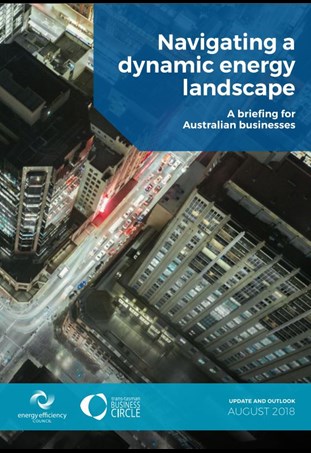Everything we know about energy is changing.
Once the management domain of operations and procurement, businesses across Australia are taking a different view of their energy usage – understanding that a cost effective, stable energy supply will no longer be assured with a traditional retail services agreement and efficiency measures seen as attractive mainly for their short pay back periods.
While await the meeting of the COAG Energy Council which will decide the fate of the National Energy Guarantee, the Energy Efficiency Council, together with the Victorian Government and the Trans-Tasman Business Circle have released a guide to strategic energy management describing the ‘new world order’ in which energy presents business with both risks and opportunities. As the Guide says, “the trends driving the transformation of our energy markets are the same trends that businesses can leverage to thrive”.
Energetics played a major role in the drafting and development of the EEC Guide and we are proud to see how positively it has been received. We encourage everyone to share this document as widely as possible. Access the guide via this link.
The three characteristics of energy market transformation
As outlined in the Guide, the current upheaval in Australia’s energy markets has distinct characteristics, but it is not unique; energy markets are transforming in similar ways around the world. Three key trends are in the process of re-defining the way businesses use, produce, and contract their energy:
1. The generation mix is changing
The transition away from fossil fuels towards renewable energy, initially driven by government policy and increasingly by renewables reaching cost-parity with fossil fuels is resulting in the decarbonisation of the electricity grid. Global climate commitments and investor pressures to decarbonise are accelerating this trend.
2. The grid is decentralising
Highly centralised, one-way electricity grids are becoming more distributed, with multiple sources of generation, storage and demand management. Energy consumers are increasingly producing energy, and a world in which businesses sell energy to other businesses is becoming more feasible, enabled by new technologies and trading platforms.
3. The demand profile is shifting
The amount of energy flowing from the grid to consumers – known as the demand profile – is shifting as more consumer needs are met by on-site renewable generation. In addition, proactive demand management is starting to play a bigger role in our energy system. Businesses are increasingly controlling not just where their energy comes from and how much they use, but when they use it, which will improve system stability and help balance electricity supply and demand.
A strategic management response – the critical elements as outlined in the Guide.
1. Leveraging information
Granular, real-time data is providing businesses with a deep understanding of how energy is being used across their operations. This information can unlock performance improvements, drive strategic decision-making and investment, and enable reporting and communication of progress against targets.
2. Calibrating investment
Businesses are using this information to understand where they should invest resources and capital, whether it be in energy efficiency, renewable energy or demand management technologies. Identifying opportunities to change how and when energy is used, and investing where cost effective, is setting these businesses up for future growth and competitiveness.
3. Optimising contracting
As well as optimising their own operations, businesses are exploring innovative contracting strategies to source the remainder of their energy requirements. Businesses are ensuring they are not passive price-takers and are assessing alternate solutions to meet their energy needs.
Businesses are backing renewables as part of a strategic approach to energy management
In the past, most large energy users handed the management of electricity market risks to their retailers. The typical retail services agreement was a fixed price contract. When wholesale futures contract prices were low and flat ($35-$40 per MWh) such arrangements suited end-users as quantifying, managing and hedging volume and price risk is core business to energy retailers. However, the recent dramatic cost increases across the NEM years led large customers to question the appropriateness of passively accepting the transfer of price risk. Coinciding with the rise in grid-supplied electricity costs, the cost of renewable energy production fell; narrowing the price difference between renewable and traditional energy sources. For large energy users contracting with a renewable energy generator and/or retailer to meet all or part of their energy needs became a commercially viable proposition. Read more in Energetics’ corporate PPA deal tracker shows the scale of the developments and the states in which projects are located. See our dedicated Corporate renewable PPA tracker knowledge centre.
Energetics can help your business tailor an energy strategy to meet you risk management requirements and explore opportunities to create a competitive difference. Contact your Energetics’ account manager or any one of our experts.
Related insights
-
Corporates bring energy procurement and climate risk strategies together
READ MORE -
Does your business have the flexibility to schedule electricity use?
READ MORE -
The financial markets have spoken: the future lies in clean energy
READ MORE -
It’s not just price – a corporate renewable PPA is a risk management strategy
READ MORE




